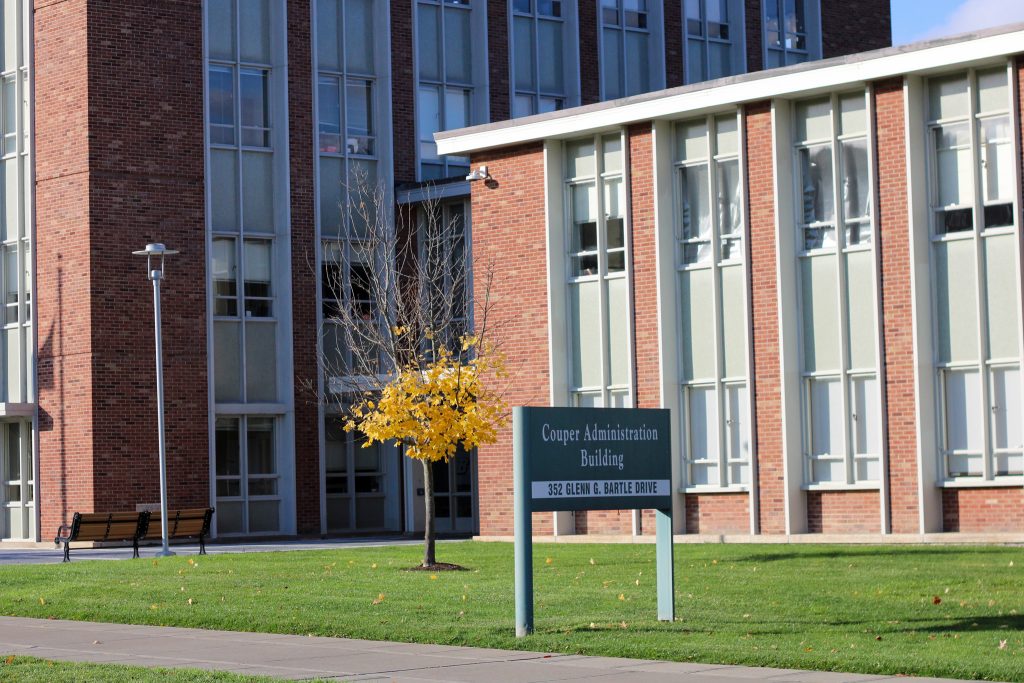Binghamton’s New York State University Police Department (UPD) will now use body-worn cameras when receiving service calls.
The usage of body cameras was first recommended by the Campus Citizen Review Board (CCRB), as part of a SUNY-wide initiative. BU will be joining at least 16 other SUNY schools who have already instated the new protocol. The cameras are to be worn when UPD responds to service calls, and the footage acquired will be stored in a storage system, where it can be accessed as needed.
Karen Jones and Mathew Johnson, co-chairs of the CCRB, said the board believes that the body-worn cameras will benefit both the campus community and UPD officers.
“The CCRB recently met with Interim Chief [Matthew] Rossie to get an update on the body-worn cameras,” Jones and Johnson wrote in an email. “The board appreciated the way in which the recommendation has been implemented and believes that consistent use of body-worn cameras will promote accountability, trust and communication among the [BU] campus community and the [UPD].”
The promotion of transparency between the UPD and campus community has been an ongoing process, with the CCRB and UPD making several policy changes in the past two years. Last year, they reviewed and surveyed the campus community on behalf of community safety. The CCRB and UPD created six subcommittees for the UPD, in light of the Black Lives Matter Movement, to research recommended action for certain altercations.
Rossie explained why the issuing of body-worn cameras was delayed — after originally being scheduled for inauguration last year.
“The equipment, including the cameras and storage space, was ordered in fall 2021 and was expected to be delivered by Thanksgiving but was delayed by supply chain issues, and we finally received the cameras in May,” Rossie wrote in an email. “Once they arrived, a Florida police officer familiar with the system we are using came here for an all-day training of our trainers.”
The UPD has been trained to use their phones in conjunction with the body-worn cameras, according to BingUNews. With an app on their phone, officers tag the recorded video footage with a case number, which will be uploaded to a larger storage system at the end of their shift.
The videos will then be stored for a time period that depends on the manner of the service call. All videos are kept for at least 180 days, but footage pertaining to higher offense charges — such as felonies and fatal accidents — will be kept for longer. The UPD can now refer to their video recordings when filing for their case, holding themselves and the community accountable for collective action. According to Rossie, usage of these cameras has been going smoothly.
The current cost and training of camera use is $64,000, with an annual estimate of $28,000 for storage, as stated in a BingUNews article.
According to the CCRB, the new measures are meant to promote accountability and trust between the UPD and campus community, of which some students have shared their support. Lenny Balarezo, a sophomore majoring in biology, said he did not see any cons to the new protocol.
“It keeps both parties accountable,” Balarezo said. “I don’t see any downsides to it. It’s a good way to ensure the UPD and students maintain a good relationship with each other.”
Abdur Haider, a sophomore majoring in economics, said that beyond holding the UPD accountable, body-worn cameras could also potentially allow for better safety measures — by creating a record of consistent offenses, Haider believes the UPD could assess how to better handle certain conflicts.
“Every interaction and person should be recorded as it gives us more information about what people are getting caught up for,” Haider said. “UPD will have consistent data about similar offenses, so now they can work on better preventing that offense.”



